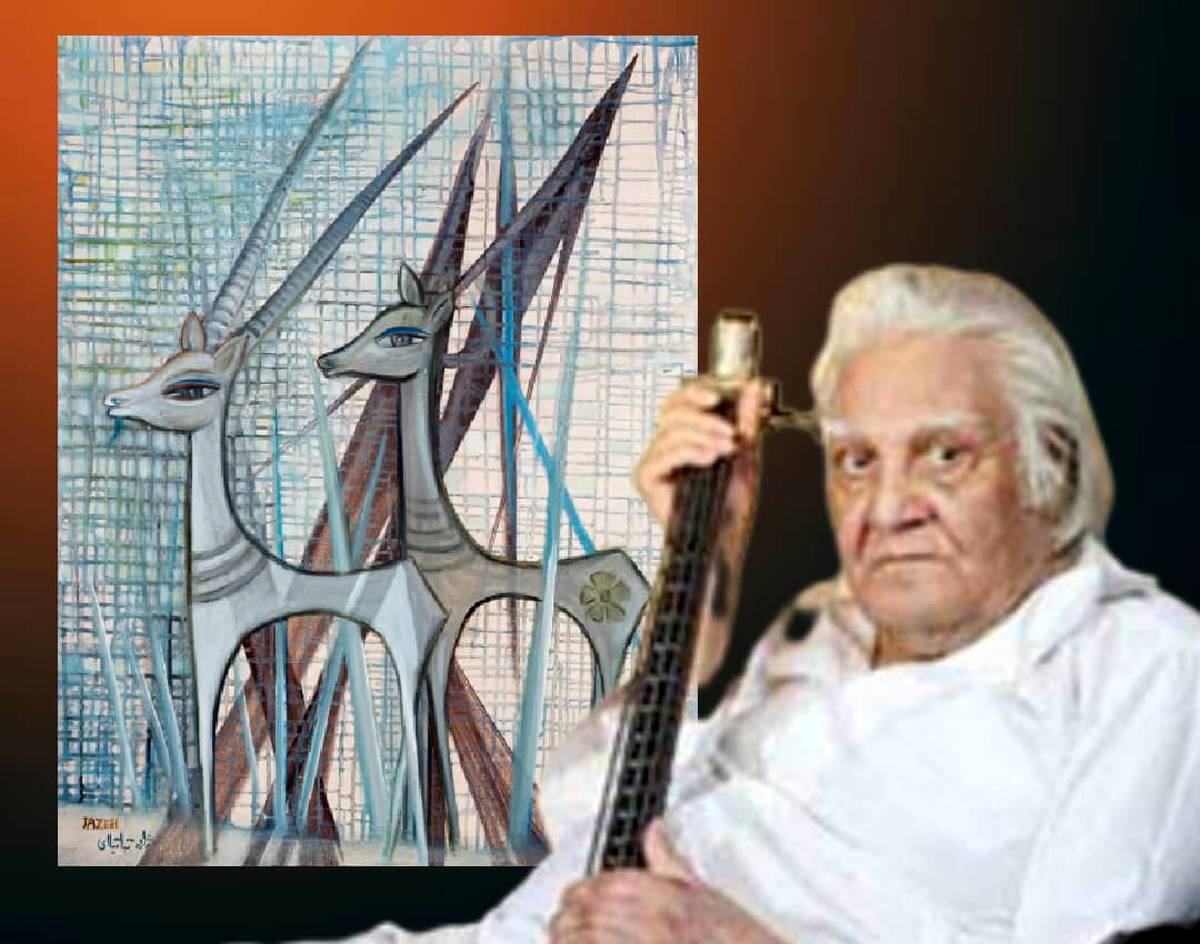
Jazeh Tabatabai and the Earthenware of Susa in the Raha Gallery Collection
The traces of goats on the painted ceramics of ancient Susa find their way into the gazelles of Persian poetry and Iranian miniature in this painting, which has endured for more than half a century. The fusion of the “mythical animal” with “geometric abstraction” embodies a quest for identity—one that remains distinctly Eastern and Iranian, yet resonates in dialogue with international modern art.
ArtDayMe – The Raha Gallery Middle East Collection, founded and directed by engineer Mohammadreza Ghaemmaghami, has for over two decades carried out sustained cultural work with a focus on advancing regional art, housing a rich array of modernist and contemporary masterpieces by Iranian and Arab artists.
Among these works is a striking untitled painting by Jazeh Tabatabai, executed in oil on canvas (70 × 90 cm) during the 1970s.

Jazeh Tabatabai (March 21, 1926, Tehran – February 9, 2008, Tehran) was an Iranian painter, sculptor, poet, and playwright. His works—both paintings and sculptures—are held in prestigious museums and private collections such as the Louvre Museum in Paris, the Metropolitan Museum of Art in New York, the Tehran Museum of Contemporary Art, private collections in Germany, and the personal collection of Jimmy Carter. His art has been exhibited in countries including the UK, France, Italy, Greece, Germany, Turkey, India, China, and the United States, earning him ten international awards.
In this canvas by Tabatabai, preserved in the Raha Gallery Middle East Collection and dating back more than fifty years, a synthesis of symbolic realism and geometric abstraction emerges.
Tabatabai distilled the figures to their barest lines and surfaces, drawing them away from nature toward abstraction. The elongated gazes and large almond-shaped eyes of the gazelles recall Persian miniature and Eastern iconography. Their pronounced eyes impart awareness and vigilance, lifting the creatures beyond mere animality and transforming them into mythical or anthropomorphic beings.
Behind them, Tabatabai constructed a lattice of vertical, horizontal, and diagonal lines—an abstract mesh that fills the pictorial space with rhythm and cadence. These lines bear a strict geometric discipline, in contrast with the fluid curves that shape the gazelle bodies. The grid may be read as a metaphor for cages, constraints, or social structures in which these elegant beings are ensnared, while their polished, simplified bodies stand in counterpoint, offering both visual and symbolic tension.

In Iranian and Eastern tradition, the gazelle has long symbolized delicacy, innocence, freedom, and beauty. The presence of a pair may suggest duality, romantic union, or coexistence. The prevailing palette—turquoise-blue, white, gray, and light brown—evokes serenity and purity (blue and white) while also implying gravity and endurance (brown and gray). The contrast between the light and dark bodies of the two gazelles, as well as between the pale blue ground and the darker linear grid, heightens the prominence of the figures.
A four-petaled flower on the body of one gazelle functions as a symbolic motif—perhaps a reference to fertility, life, or even the artist’s personal signature embedded within the work. This interplay between formalist geometry and poetic imagery epitomizes Tabatabai’s art. His painting reflects the broader endeavor of Iranian artists in the mid-20th century to forge a local visual language while engaging in conversation with global modernism.
Thus, this work is less a naturalistic depiction of gazelles than a poetic, allegorical expression of freedom, innocence, and coexistence within the confines of limitation. The gazelles appear as noble, mythic beings, poised in a transparent yet enclosed space—as though Tabatabai were simultaneously evoking the beauty of Iranian nature and culture while portraying the constraints of modern society and history.

This painting was presented at the Seventh Tehran Auction in July 2017. The auction catalog described it as follows:
> “Tabatabai’s unique paintings are as beautiful, valuable, and original as his sculptures, imbued with the artist’s profound vision. In this work one can trace the continuity from the goats of Susa’s painted earthenware to the fleeting gazelles of Persian poetry and Iranian miniature. Through a firm composition and a restrained chromatic scheme, the artist distills the animal form into an archetypal motif, transforming it into a symbol. Flattened surfaces, avoidance of volume, and simplified anatomy reimagine ancient emblems within a modern idiom. Tabatabai may rightly be called a master of renewing the art of yesterday. His alchemy of imagination breathes fresh, almost messianic spirit into native and national traditions. The nostalgia of Iranian heritage—miniature painting, pottery, tilework, and architecture—becomes raw material in his hands, fused with formal modernist strategies into new creation. The exaggerated bodies of the two animals—their elongated horns, stylized forms, and expressive eyes—create a lyrical atmosphere enhanced by the soft tonalities of turquoise, ochre, cream, and white. The vertical and horizontal lines of the ground, while echoing Western modernist abstraction, also recall Iranian weaving and basketry. The horns of the right-hand gazelle merge subtly with tree-like forms in the background, binding animal and plant in organic unity, while the flower motif on one body harks back to the ornamental imagination of Eastern tradition.”
This remarkable work belongs to the Raha Gallery Middle East Collection.

LEAVE A RELPY